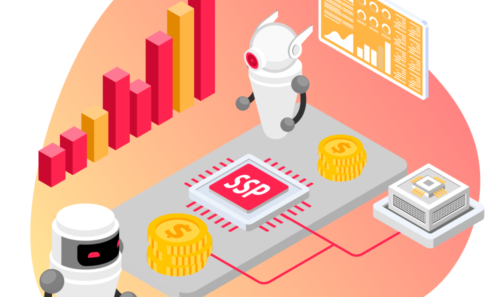Why In-house Programmatic Is Not Always a Good Idea
Programmatic advertising has become an integral part of digital marketing strategies, with companies investing heavily in this automated buying and selling of ad inventory. According to Statista, programmatic spending worldwide is projected to reach $98 billion by 2021.

With such significant investments, there’s no surprise that digital publishers are willing to manage their programmatic inventory on a high level, so they go to ready-to-use solution providers or try it in-house. But what’s a better choice?
In this article, we will explore why in-house programmatic is not always the best idea and highlight the benefits of using external programmatic solutions so you can make an informed decision.
Pros of in-house programmatic
In-house programmatic advertising can appeal to companies seeking greater control over their advertising efforts and cost savings. It promises advantages such as increased visibility, data protection, and eliminating intermediaries, potentially leading to improved return on investment.
However, there are important considerations that many brands underestimate when it comes to implementing and maintaining an in-house programmatic stack.
Before developing an in-house programmatic solution, assessing your organization’s capacity across three critical categories: people, process, and technology, is crucial. Ask yourself if you have the right people to make it work, if the solution will integrate smoothly with your existing systems, and if the technology will simplify or complicate access to valuable insights. You should reconsider your decision if you lack the necessary expertise or resources in any of these categories.
Despite the perceived benefits, several factors can make in-house programmatic challenging. Here are a few reasons why in-house programmatic may not always be the best idea.
7 Challenges of building programmatic in-house
1. Lack of relevant competencies
Implementing an in-house programmatic solution can be particularly challenging when an organization needs more qualified staff and the necessary skills and expertise. Programmatic advertising relies on a deep understanding of technology, data analysis, and advertising strategy. Without the required expertise, setting up and optimizing programmatic campaigns becomes difficult, resulting in wasted ad spend and subpar performance.
Acquiring and retaining the right programmatic talent poses a real challenge. Nevertheless, establishing an in-house programmatic team necessitates expanding the staff size. Therefore, recruiting individuals with a skill set that complements your current team will be necessary. However, sourcing the appropriate expertise can be demanding. You’ll seek individuals with a unique combination of in-depth strategic marketing knowledge, data analysis proficiency, a firm grasp of programmatic technology, and refined technical skills. In addition, it’s essential to consider that the programmatic industry constantly evolves, requiring staff to have ongoing educational opportunities to stay updated with industry changes.
In some cases, the cost of hiring and maintaining an in-house team may outweigh the benefits, making engaging with an external company more financially viable.
2. Lack of adequate resources to create the technology
Lack of adequate resources to develop the necessary technology can pose a significant challenge in implementing an in-house programmatic solution. Creating a robust programmatic infrastructure requires substantial investment in technology, including demand-side platforms and brand safety tools. It also involves accessing and leveraging various data sources for effective targeting and campaign optimization. These resources may require significant upfront costs and ongoing maintenance expenses.
Furthermore, building and maintaining the technology stack for programmatic advertising requires specialized expertise and technical know-how. And as you already know, without skilled programmers, data analysts, and technology infrastructure, it becomes challenging to create and sustain an efficient in-house programmatic system.
3. Time of development & implementation
Developing and implementing an in-house programmatic solution is time-consuming due to several factors. One of the main reasons is that building a complete in-house solution takes an estimated 12-18 months to set up., even with a qualified team. This timeframe accounts for the various stages involved, including planning, development, testing, and deployment.
Organizations need to address change management and problem-solving to establish an effective in-house programmatic system. This entails restructuring existing processes and workflows to accommodate the new system and resolving any technical or operational challenges that may arise along the way.
Furthermore, implementing an in-house programmatic solution requires establishing a centralized data infrastructure. This involves creating a robust data management framework to handle the vast amounts of data generated by programmatic advertising campaigns. Building such infrastructure takes time and effort to ensure data accuracy, security, and accessibility.
In addition to data infrastructure, organizations need to set up a connected ad tech setup. This involves integrating different advertising technologies, such as demand-side platforms (DSPs) and supply-side platforms (SSPs), to facilitate programmatic ad buying and selling. Configuring these systems to work seamlessly and aligning them with the organization’s specific requirements can be complex and time-consuming.
4. High costs
Despite the perception that in-house programmatic can lead to cost savings, it can be expensive. Building and maintaining a programmatic infrastructure requires a significant investment in technology, including fees for demand-side platforms and brand safety tools. Additionally, costs are associated with acquiring and utilizing additional data to compensate for perceived savings in external media buying. Hiring new skilled personnel further adds to the expenses. Furthermore, companies often overlook the hidden costs that agencies bear. When partnering with a buying entity, you gain access to their existing vendor relationships without incurring the expenses, time, effort, licensing, subscriptions, and legal fees associated with maintaining those relationships. By relying on a buying partner to handle programmatic advertising, you only pay for your services, benefiting from pre-existing economies of scale that reduce fees and meet platform minimums. The partner takes care of the upfront costs of hiring, training, onboarding, and scaling.
Moreover, using in-house tools solely for internal needs can be inefficient and financially unfavorable. Publishers may find it necessary to sell their solution externally to recoup some of the costs, but this can lead to a significant loss of focus and diversion of resources.
5. Scale and reach
Implementing an in-house programmatic solution may present limitations in terms of scale and reach compared to collaborating with an external programmatic partner. However, external programmatic partners often have access to a diverse array of inventory and data sources, granting them the ability to execute highly targeted and impactful campaigns.
Furthermore, in-house programmatic efforts may struggle to match the scale and reach offered by external partners. These partners possess a wider range of inventory and data sources, empowering them to deliver precise and efficient campaigns. By partnering with an external programmatic provider, companies can leverage their extensive expertise, resources, and cutting-edge technology, which can be challenging to replicate internally.
6. Problems with maintaining technology
In addition to developing an in-house programmatic solution, the company must allocate resources to maintain the technology and ensure its continuous functionality in line with market trends. It necessitates ongoing monitoring, maintenance, and optimization to ensure the system’s smooth operation and maximize its effectiveness. This continued effort can strain internal resources and require dedicated personnel to handle day-to-day operations, troubleshooting, and performance analysis.
Moreover, even if the company possesses the expertise and financial resources to establish an in-house programmatic operation, keeping up with the ever-evolving programmatic landscape can still be challenging. The programmatic industry constantly evolves with new ad formats, targeting techniques, and data privacy regulations emerging regularly. Staying up-to-date with these changes requires a dedicated team and significant resources.
To stay competitive and effectively leverage programmatic advertising, companies must invest in continuous learning and development to keep their in-house team abreast of the latest trends and best practices. This involves attending industry conferences, participating in training programs, and staying informed about industry news and updates.
Additionally, programmatic technology constantly evolves, introducing new platforms, tools, and features. Therefore, maintaining an up-to-date programmatic infrastructure requires ongoing investment in upgrading and integrating new technologies and ensuring compatibility with various platforms and data sources.
7. Absence of Neutral Judgement
Last but not least disadvantage of in-house programmatic is the potential lack of objectivity. When managing programmatic campaigns internally, there is a risk of biased decision-making and missed opportunities. In addition, the team responsible for the campaigns may be directly involved in the brand’s operations, making it challenging to maintain a completely objective perspective based on data analysis. This lack of objectivity can lead to poor campaign performance and suboptimal outcomes.
Working with an external programmatic partner can help mitigate this issue by providing an unbiased perspective and leveraging their data analysis and campaign optimization expertise. They can offer a fresh and objective viewpoint, ensuring that decisions are based on comprehensive data insights rather than internal biases. This impartiality can lead to more effective targeting, better campaign performance, and improved overall results.
In-house programmatic is not always an ideal solution
In conclusion, while in-house programmatic may seem attractive, weighing the potential challenges and limitations it presents is essential. By leveraging external expertise and technology, companies can achieve better results, maximize their revenue, and stay ahead in the ever-evolving programmatic advertising landscape.
Implementing ready-to-use technology advanced programmatic solutions from trusted partners like Yieldbird can save human resources, time, and money significantly. Yieldbird Platform provides transparent, efficient, and cost-effective solutions for managing programmatic ads for digital publishers. By leveraging Yieldbird’s expertise, publishers can optimize their programmatic campaigns, improve revenue streams, and focus on their core business, without the burden of developing and maintaining an in-house programmatic infrastructure.
Ready to take your programmatic advertising to the next level? Contact our experts today and discover how the Yieldbird Platform can help you effectively manage programmatic ads for your digital publishing needs.
LET’S GET IN TOUCH!

Vadym Kriuchok
Customer Success Team Leader
publishers@yieldbird.com






